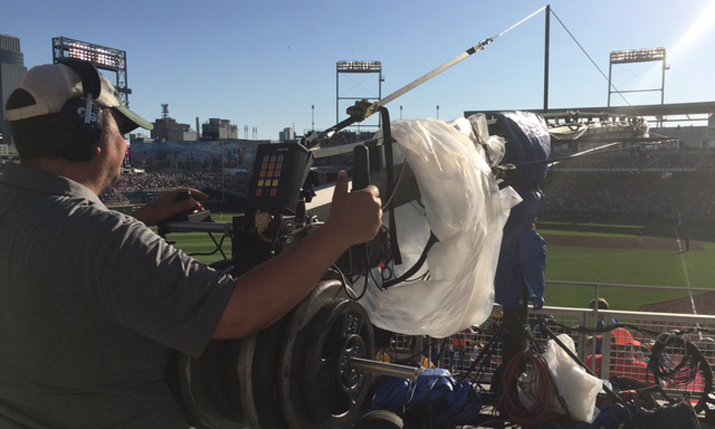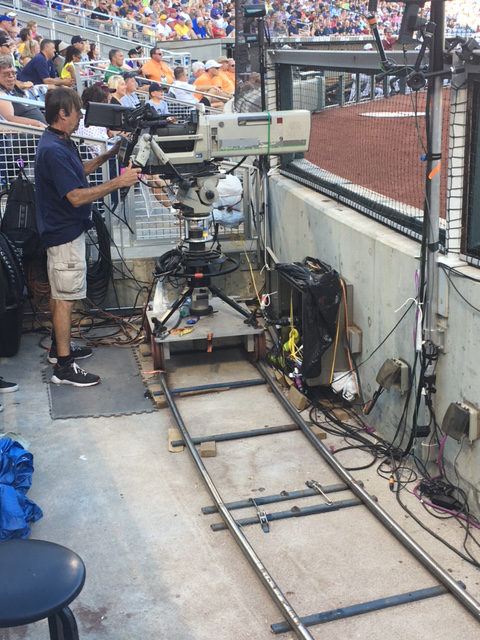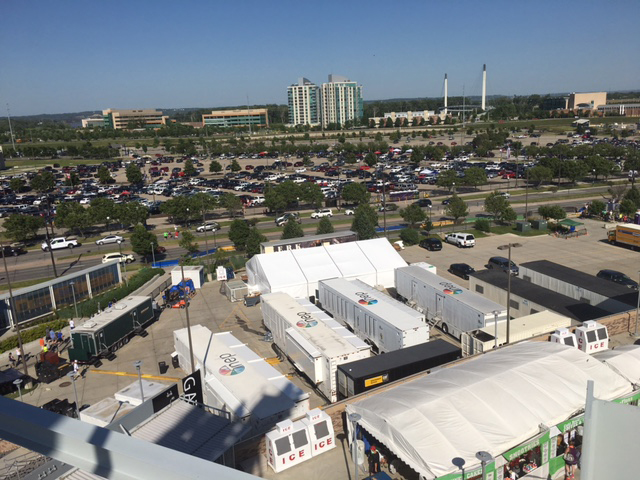ESPN’s College World Series Production Brings Back Some Classics While Continuing Tradition of Innovation
Bexel’s Clarity 800, NEP’s Supershooter 24 make Omaha debuts
Story Highlights
Few sporting events capture the classical, nostalgic essence of sport and Americana more than the NCAA College World Series. Few sporting events also offer a riper stage for broadcasting innovation.

ESPN has brought back a jib camera over the left field fence at this year’s coverage of the College World Series.
As the 2017 edition of the College World Series reaches its nadir this week with SEC rivals Florida and LSU battling it out in the best-of-three final, ESPN is spreading its wings in the event’s second year at the new TD Ameritrade Park in Omaha, Nebraska. The network has brought with it an evolving approach to how it deploys its cameras, a new production truck, and an aggressive audio strategy that will keep up the annual tradition of innovation at this crown jewel event.
“All of the stuff we get to play around with and we get to experiment with [in Omaha] is thanks to the people [at TD Ameritrade Park] and the NCAA,” says Jarrett Baker, remote operations associate manager for ESPN. “The building here is such a fantastic host. They let us think outside the box and they think along with us. Plus, the NCAA is 110% behind us and wants us to be able to tell the stories like stories have never been told.”
Classic Camera Angles With An Innovative Flair
Chris Swihart, the remote operations producer on this year’s event, calls this year’s camera deployment a “renaissance year” for ESPN because the network has “come back to some positions that we’ve used in the past.” After trying some different things, ESPN is excited to go back to a few classic angles, including a high-home camera position that is notably lower than similar angles seen on traditional baseball telecasts.

A total of 25 cameras are deployed around TD Ameritrade Park, including this hard camera behind home plate that’s installed on a track for added mobility.
“It’s a really cool thing,” says Swihart. “Having the vantage from the low home position gets us some really great, tight close-ups of the pitcher. You can see the fire in his eyes right before he throws the pitch. Those are just great shots and they make the sport look great and they really convey the intensity and the emotion of the game to our viewers.”
ESPN has also brought back a 39-foot jib that is positioned just over the left-field wall that delivers quintessential sweeping shots over the packed bleachers and beauty shots that encapsulate the feel of being there for viewers at home.
In addition, this event is the latest deployment in the industry of the new Bexel Clarity 800 High Speed Camera. According to ESPN producer Steve Ackles, the crew is using the small — almost cell-phone sized device — with a Panasonic Lumix G 45-175 Zoom lens. It has been running at 180 fps (frames-per-second).
“There’s some great replay looks that we’ve been able to get from it so far,” says Swihart. “We’re not using to having super slow-mo replay on angles like that very often so we’ve been able to do some interesting things with some of our teases and rollouts and those sorts of things because of the super-mo aspect of it as well.”
At-Home Workflows Compliment SEC Network Integration
ESPN has rolled in with a new footprint in the production compound with the introduction of
NEP’s Supershooter 24 (along with its B and C units) offering the crew on site more modern and spacious facilities in which to work. The added area has also opened the opportunity to leverage technologies in an at-home model in order to dial up more content for the SEC Network.
According to Baker, ESPN is deploying a bit of a hybrid production model to support SEC Network and leaning on the network’s experience in at-home (or as ESPN refers to them, REMI) workflows.
A line cut from Omaha of two handheld cameras are being cut on a aux router off of the truck’s Grass Valley Kayenne switcher and being sent back to SEC Network’s Charlotte facilities for the adding of graphics, music, postproduction editing, etc. Even with a studio set on site for SEC Network, the truck is sending back select beauty cameras back from Omaha on separate transmission paths to Charlotte, as well, to get them fully integrated into the pre- and post-game shows. From there, the producer and director in Charlotte can communicate with the talent on-site via IFB.
Aggressive Audio Innovation Remains a Hallmark
One of the areas where ESPN really likes to push the envelope on the event is in its audio work. More than 100 microphones are deployed through the ballpark and the surrounding grounds. There’s a liberal use of RF mics, as well, allowing for placement in the bags, in the pitching rubber, in the outfield walls, in the foul poles, in the bullpens, on umpires, and even near family and friends of players and coaches in the stands.
“Thanks to the days upon days that we spend here we’re able to sort of entrench ourselves a little deeper than we normally would in a normal typical one game environment,” says Swihart. “I think people are used to watching Major League baseball on TV but when you watch college baseball you want to capture that passion for the school, the players, and the families [that are unique to this] baseball environment. We have to sort of re-engineer our audio approach on the College World Series capture all of that.”

